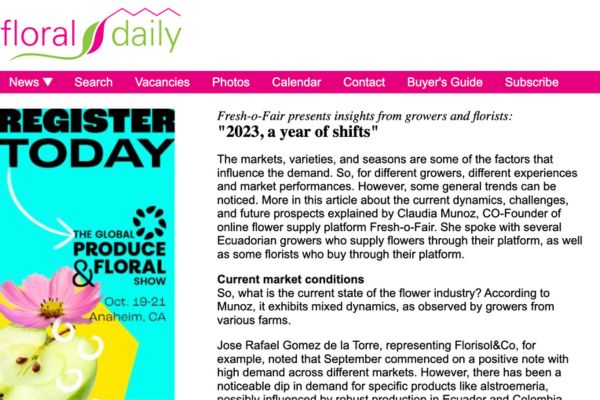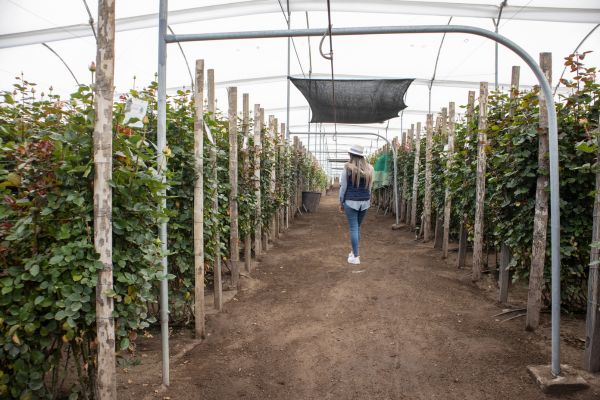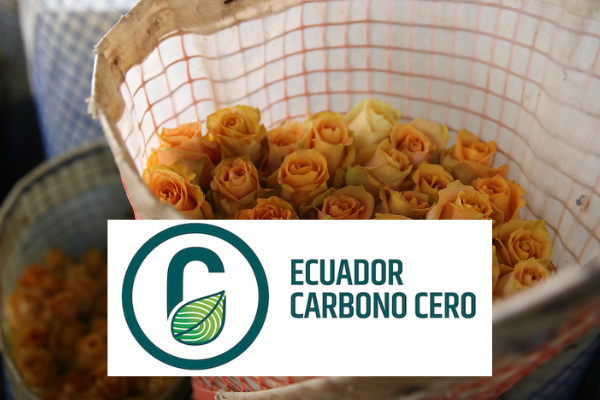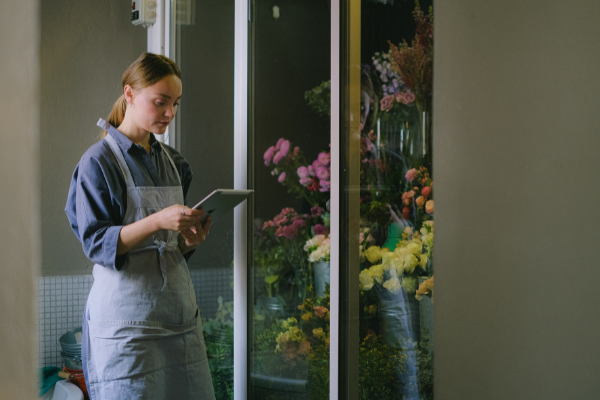2 years, 3 months ago
Fresh-o-Fair presents insights from growers and florists:
The markets, varieties, and seasons are some of the factors that influence the demand. So, for different growers, different experiences and market performances. However, some general trends can be noticed. More in this article about the current dynamics, challenges, and future prospects explained by Claudia Munoz, CO-Founder of online flower supply platform Fresh-o-Fair. She spoke with several Ecuadorian growers who supply flowers through their platform, as well as some florists who buy through their platform.
Current market conditions
So, what is the current state of the flower industry? According to Munoz, it exhibits mixed dynamics, as observed by growers from various farms.
Jose Rafael Gomez de la Torre, representing Florisol&Co, for example, noted that September commenced on a positive note with high demand across different markets. However, there has been a noticeable dip in demand for specific products like alstroemeria, possibly influenced by robust production in Ecuador and Colombia, resulting in decreased demand for this particular flower type. Conversely, Bellaflor highlights that the market is gradually reawakening following the summer period, with anticipation building for the upcoming fall/Thanksgiving season. This shift in demand corresponds with the seasonal transition. Kiara Flowers, a preserved flower farm, reports a market in a state of reaction, anticipating strong sales projections as the year draws to a close.
"These diverse market observations underscore the nuanced and dynamic nature of the floral industry, where factors like seasonality, product variety, and market trends continually influence market performance."
Demand in 2023: A year of shifts
But how is this year compared to 2022? Jose Rafael Gomez de la Torre acknowledges the pandemic's initial boost to flower demand. However, by 2022, demand had already started declining, with a 20% decrease in sales at one of their supermarkets, he says.
Meanwhile, Bellaflor observes that each year presents distinct market dynamics, with the upcoming fall season showing promise for concluding the second half of the year on a positive note. Similarly, Kiara Flowers, a preserved flower farm, holds optimistic expectations, aiming for a 10% growth rate over the previous year. Despite a subdued summer, they anticipate compensating for this with robust end-of-year sales.
In contrast, Fresh-o-Fair has observed an increase in online marketing demand compared to the previous year. "Despite being a smaller company, we cannot solely attribute this growth to the online industry or the overall fresh-cut flower export industry."
According to Munoz, these varying insights underscore the ever-evolving nature of the flower market, shaped by a multitude of factors and exhibiting nuanced trends year after year.
Growers' Concerns: Climate change and more
When looking at the challenges, climate change seems to be at the top. Climate change is taking a toll on the floriculture industry not only in Ecuador but also in Colombia and other parts of the world, Munoz continues. "It is affecting growers' satisfaction with the demand, weather conditions, and product quality."
At Fresh-o-Fair, they are aware of the industry's vulnerability to climate change, and according to Munoz, several key issues demand attention.
"Firstly, climate change brings unpredictable weather extremes, including excessive rainfall and severe droughts, disrupting traditional growing practices. These erratic shifts jeopardize crop stability both in terms of quantity and quality. Additionally, there is a disheartening trend of denial regarding climate change within some segments of the industry, hindering collective efforts to address this pressing issue. Furthermore, the absence of government support for adaptation strategies compounds the challenges, preventing essential investments in infrastructure improvements."
She highlights that some growers, such as Ecoroses, are taking proactive steps to address climate challenges, emphasizing the need for industry-wide adaptation. "In the coming decade, quality is expected to be a focal point for the floriculture sector, emphasizing sustainability as the key to ensuring superior flower quality. By purchasing fresh products directly from sustainable farms and supporting producers committed to environmentally friendly practices, we can secure the industry's future while ensuring top-quality flowers."
And according to Munoz, the industry urgently needs to adapt its greenhouse construction and infrastructure to what is coming. "As Fresh-o-Fair, we know firsthand that there has not been any innovation in the construction of greenhouses in the last decade."
Floral Trends: Colors in demand
"Flowers and colors remain in demand based on the season. As autumn approaches, warm shades like terra-cotta and mustard, along with rich, dark hues, are highly sought after. US retailer and wedding florist Alyssa van Guilder at Apotheca Flowers emphasizes the role of social media in shaping floral trends, with dyed florals also enjoying popularity."
And Florisol & Co. recognizes the market's increasing demand for seasonal colors. "Meeting this challenge requires aligning production with the season's trending colors. While it's relatively straightforward for chrysanthemums, adjusting rose production presents an additional challenge."
Diversification among Ecuadorian growers
The growing trend of Ecuadorian growers diversifying their product range is undoubtedly reflected in Fresh-o-Fair's offerings, as affirmed by the insights shared by various farms. "Jose Rafael Gomez de la Torre from Florisol&Co emphasized the value of offering a broad spectrum of products, underscoring the uniqueness it brings to their customer base. Their commitment to innovation is evident in the increasing popularity of "combo boxes," an approach that simplifies the shopping experience for customers, who can conveniently find an array of floral products in one place. This strategic approach extends beyond product diversification, encompassing enhancements in customer service and production methods. Their overarching goal is to excel in the competitive flower markets by delivering consistently fresh and top-quality products, aligning closely with the evolving demands of the floral industry."
Bellaflor, another participating farm, recognizes the competitive edge that product diversification provides. "Offering a wide variety of products not only simplifies the shopping experience for customers but also positions them as a one-stop solution for floral needs. This adaptability to meet diverse customer demands underscores the commitment of farms like Bellaflor to provide convenience and variety to their clientele."
And Kiara Flowers exemplifies the importance of adaptation in response to market demand. "Their focus on monitoring market trends and aligning their production accordingly has led them to expand into the production of preserved hydrangea, gypsophilia, carnations, and ambitions to preserve orchids. This dynamic approach to product diversification ensures that they remain responsive to changing market preferences, reaffirming the industry's commitment to staying competitive and customer-focused."
Florists' Experiences in 2023
When looking at the florists' side of the story, 2023 has created a dynamic landscape for them, prompting them to respond to shifting industry dynamics with resilience and adaptability, Munoz explains.
Alyssa van Guilder shares her perspective on the year. She acknowledges that the post-COVID period has been marked by significant recovery efforts. Looking back to the previous year, Alyssa describes the challenges she faced due to the skyrocketing costs of flowers and supplies. However, 2023 presents a more promising picture. The industry seems to be stabilizing, which is making profitability more attainable and predictable. For Alyssa and others, this stabilization signifies a return to a more comfortable and sustainable business environment. "As the industry recovers from the shockwaves of the pandemic, van Guilder's experience exemplifies the resilience and determination of florists to thrive despite adversity."
Isa Entre Flores, another florist in the industry, paints a nuanced picture of her experiences in 2023. She highlights the variations in her year, noting that the first part was relatively more successful in terms of event-based floral arrangements. However, she also candidly shares that the retail side of her business faced challenges, especially in comparison to previous years. Starting from June and extending throughout the summer, including the current month of September, Isa characterizes the business environment as unusually slow. Additionally, Isa mentions the need to compensate for the slow retail sales with a focus on event-based floral services. However, this has not been without its challenges, with the summer season proving unexpectedly slow for event-related business, especially when compared to the vibrant post-COVID summers.
"While the industry grapples with its unique challenges and opportunities, these dedicated individuals continue to play a vital role in creating beautiful floral arrangements and sustaining the floral market's growth. Their adaptability and resilience will undoubtedly shape the floral landscape in the years to come", says Munoz.
Florists' specific needs
According to Munoz, the floral industry continues to evolve, and florists have found themselves adjusting their preferences and requirements to navigate the shifting market landscape effectively. "Van Guilder emphasizes that the experiences of 2020 led florists to pivot away from hyper-specific flower choices towards focusing on providing customers with a distinctive "look and feel." This shift reflects a broader trend within the industry, where florists are striving to offer unique and visually appealing arrangements that capture the essence of an event or occasion."
One notable change is the increasing demand for flexibility from wholesalers and farmers, Alyssa van Guilder highlights. "Florists, once known for their specific flower requests, now find themselves adapting to a more dynamic marketplace. This shift has been driven, in part, by supply chain challenges, which have made securing particular flower varieties more challenging. As a result, florists are developing closer relationships with their suppliers, fostering trust and cooperation to meet customer demands."
Isa entre Flores explains that "The ease of purchasing flowers remains a fundamental requirement, accompanied by a desire for price stability rather than necessarily low prices." As Munoz says, "This shift towards stable pricing reflects the industry's understanding of the need to balance costs without compromising quality. Additionally, a focus on the high quality of flowers underscores florists' commitment to delivering top-tier products to their customers."
Fresh-o-Fair's perspective
But what is Fresh-o-Fair's perspective? They have seen an increase in sales compared to the previous year. They attribute this growth to their positive approach and willingness to embrace change.
"Fresh-o-Fair, as an industry player, recognizes that the specific needs of florists can vary based on their client base. Retailers and event florists may seek different products, reflecting the diverse nature of the floral market. Importantly, florists now have direct access to farms, enabling them to experiment with new products and reduce their dependence on traditional wholesalers. This newfound flexibility comes with its own set of challenges, including the need to test consumer responses to new offerings. Fresh-o-Fair's commitment to bridging the gap between florists and farms highlights the importance of collaboration and communication within the industry."
To facilitate this dialogue and address the evolving needs of florists, Fresh-o-Fair is organizing its second international florist trip to Ecuador in May 2024. This initiative aims to foster direct interactions between producers and florists, allowing for valuable feedback and innovation. "As the floral industry continues to transform, florists are adapting and redefining their needs, contributing to a vibrant and dynamic marketplace where flower dreams can indeed come to life."
Future Plans for Fresh-o-Fair
The company has ambitious plans, including a focus on sustainability and traceability. They are inspired by the concept of traceability, aiming to implement a system similar to Tony's Chocolonely. "We believe that knowing the source of products is crucial for a sustainable future in the industry. We also encourage consumers to consider the hidden costs behind very cheap flowers. Our biggest 'secret' and soon to be released is traceability."
And as the floral industry evolves, so do its challenges and trends. "Quality and sustainability are paramount, and industry players adapt to changing demands. Fresh-o-Fair's message is clear: "Buy smart, buy at fresh-o-fair.com." This call resonates with the industry's shift toward transparency and sustainable practices."
Publication date: Thu 21 Sep 2023
Author: Elita Vellekoop
© FloralDaily.com
Read the original article here: https://www.floraldaily.com/article/9560730/2023-a-year-of-shifts






